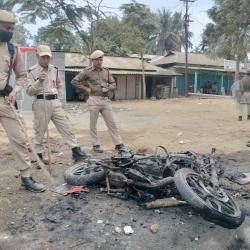The Oxford Dictionary defines the word sacrifice as the voluntary relinquishing of something valued or surrender of possession as offering to deity.
Animal sacrifice (of goats and buffaloes) is otherwise rare but is held on certain festivals in contemporary India, and Sri Lanka, especially to honor the Mother Goddess (Durga) by the followers of certain cult groups of Hindus belonging to the sect of Shaktism. Due to severe condemnation by most other Hindus, calling this as a barbaric act, these animal sacrifices are quickly disappearing in India and Sri Lanka. Among the Hindus of Nepal, and certain sections of Bengal and Assam animal sacrifices are common even today, not only for the Mother Goddess, but also for almost all deities of the Hindu pantheon. The Hindu way of slaughtering the animal may be less painful than others, as it involves an immediate severing of the whole neck of the animal by one quick stroke of a sword or an axe (otherwise great calamities are believed to befall the sacrificer), rather than slitting of the throat.
In ancient times it was also common to offer the life of a human being to a god. The Aztecs sacrificed thousands of victims (often slaves and servants were killed or buried alive along with dead kings in order to provide service in the afterlife) A similar tradition also existed in China. The Celts and German people are among the European peoples who practiced human sacrifice in the past.
The human race is a shrewdest of all races on the earth. The ancient people steeped in pagan culture and primitive superstition believed that human sacrifice would placate the enraged god and expiate their sins, this practice was particularly common among the agricultural people who sought to guarantee the fertility of the soil or avert calamities in the form of flood or famine and therefore followed the ritual of human sacrifice. But gradually when the covers of primitivism were dispelled man thought it best to put an end to this savage ritual which was putting their own lives at peril. But they found an easier way out by replacing the human by innocent voiceless animals that cannot protest these barbaric acts and neither realise their end till the final blow.
The word sacrifice is to give up a possession dear to us in such a case how can an animal be representative of something dear. As the animal to be sacrificed is bought minutes before being sacrificed for a few hundreds of rupees. The devotee seeking divine blessing is in no way attached to the sacrificial animal therefore it cannot be termed as sacrifice rather it is plain slaughter or killing of an animal.
The strides of modernism has touched our entire lives than why is it that we are still steeped in religious superstition. Our culture had been plagued by other evils like Sati but we have moved away from that era. We have realised the futility of sati system. Just as we have graduated from earthen lamps to halogen lights powered by electricity similarly its time we shed our misunderstood religious trappings and take on its greater spiritual meaning of “to live and let live”.
Prayer should not lead to negativity of thoughts and actions when we create a hue and cry over killing of humans what right do we have to initiate the killing of an animal. Isn’t it time we graduated to the practice of a bloodless sacrifice in the form of flowers and fruits or exercise sacrifice in the true sense of the term by relinquishing an object of desire and not a living creature pulsating with life to fulfil a mere superstition.
Animal sacrifice (of goats and buffaloes) is otherwise rare but is held on certain festivals in contemporary India, and Sri Lanka, especially to honor the Mother Goddess (Durga) by the followers of certain cult groups of Hindus belonging to the sect of Shaktism. Due to severe condemnation by most other Hindus, calling this as a barbaric act, these animal sacrifices are quickly disappearing in India and Sri Lanka. Among the Hindus of Nepal, and certain sections of Bengal and Assam animal sacrifices are common even today, not only for the Mother Goddess, but also for almost all deities of the Hindu pantheon. The Hindu way of slaughtering the animal may be less painful than others, as it involves an immediate severing of the whole neck of the animal by one quick stroke of a sword or an axe (otherwise great calamities are believed to befall the sacrificer), rather than slitting of the throat.
In ancient times it was also common to offer the life of a human being to a god. The Aztecs sacrificed thousands of victims (often slaves and servants were killed or buried alive along with dead kings in order to provide service in the afterlife) A similar tradition also existed in China. The Celts and German people are among the European peoples who practiced human sacrifice in the past.
The human race is a shrewdest of all races on the earth. The ancient people steeped in pagan culture and primitive superstition believed that human sacrifice would placate the enraged god and expiate their sins, this practice was particularly common among the agricultural people who sought to guarantee the fertility of the soil or avert calamities in the form of flood or famine and therefore followed the ritual of human sacrifice. But gradually when the covers of primitivism were dispelled man thought it best to put an end to this savage ritual which was putting their own lives at peril. But they found an easier way out by replacing the human by innocent voiceless animals that cannot protest these barbaric acts and neither realise their end till the final blow.
The word sacrifice is to give up a possession dear to us in such a case how can an animal be representative of something dear. As the animal to be sacrificed is bought minutes before being sacrificed for a few hundreds of rupees. The devotee seeking divine blessing is in no way attached to the sacrificial animal therefore it cannot be termed as sacrifice rather it is plain slaughter or killing of an animal.
The strides of modernism has touched our entire lives than why is it that we are still steeped in religious superstition. Our culture had been plagued by other evils like Sati but we have moved away from that era. We have realised the futility of sati system. Just as we have graduated from earthen lamps to halogen lights powered by electricity similarly its time we shed our misunderstood religious trappings and take on its greater spiritual meaning of “to live and let live”.
Prayer should not lead to negativity of thoughts and actions when we create a hue and cry over killing of humans what right do we have to initiate the killing of an animal. Isn’t it time we graduated to the practice of a bloodless sacrifice in the form of flowers and fruits or exercise sacrifice in the true sense of the term by relinquishing an object of desire and not a living creature pulsating with life to fulfil a mere superstition.
- Add new comment
- 16698 reads










Comments
Pages
Add new comment